Beko DNE 65020 X, DNE 65020 PX, DNE 68620 H, DNE 68620 T, DNE 68620 E User manual [EN,DE,FR,NL,SK,IT,RU,AR,UK]
...
Refrigerator
Kühlschrank/ Gefrierschrank Congélateur / réfrigérateur Koelkast
Chladnička
Frigorifero
Холодильник
Холодильники
DNE 65020 X DNE 65020 PX DNE 68620 H DNE 68620 T DNE 68620 E DNE 70623 DNE 70623 T DNE 62020 B
Please read this manual first!
Dear Customer,
We hope that your product, which has been produced in modern plants and checked under the most meticulous quality control procedures, will provide you an effective service.
For this, we recommend you to carefully read the entire manual of your product before using it and keep it at hand for future references.
This manual
•Will help you use your appliance in a fast and safe way.
•Read the manual before installing and operating your product.
•Follow the instructions, especially those for safety.
•Keep the manual in an easily accessible place as you may need it later.
•Besides, read also the other documents provided with your product.
Please note that this manual may be valid for other models as well.
Symbols and their descriptions
This instruction manual contains the following symbols: C Important information or useful usage tips.
A Warning against dangerous conditions for life and property. B Warning against electric voltage.

CONTENTS |
|
|
1 |
The refrigerator |
3 |
2 Important Safety |
|
|
Warnings |
4 |
|
Intended use...................................... |
4 |
|
For products with a water dispenser;.6 |
||
Child safety........................................ |
6 |
|
Compliance with WEEE Directive and |
||
Disposing of the Waste Product: ....... |
6 |
|
Compliance with RoHS Directive:...... |
6 |
|
Package information.......................... |
6 |
|
HCA Warning..................................... |
7 |
|
Things to be done for energy saving... |
7 |
|
Recommendations for freshfood |
|
|
compartment..................................... |
7 |
|
3 |
Installation |
8 |
Points to be considered when re- |
|
|
transporting your refrigerator.............. |
8 |
|
Before operating your refrigerator....... |
8 |
|
Electric connection............................. |
8 |
|
Disposing of the packaging................ |
9 |
|
Disposing of your old refrigerator........ |
9 |
|
Placing and Installation....................... |
9 |
|
Adjusting the legs............................. |
10 |
|
Floor balance adjustment................. |
10 |
|
4 Preparation |
11 |
5 Using your refrigerator |
12 |
Temperature setting button.............. |
12 |
Setting the temperature of your |
|
refrigerator....................................... |
12 |
Dual cooling system......................... |
12 |
Hygiene - Ion ................................... |
13 |
Humidity control in the crisper.......... |
13 |
Sliding Body Shelves........................ |
13 |
Blue light ......................................... |
14 |
Chiller compartment......................... |
14 |
Description and cleaning of odor |
|
filter:................................................. |
14 |
Icematic and ice storage container .. |
15 |
Dual cooling system:........................ |
16 |
Freezing fresh food........................... |
16 |
Recommendations for preservation of |
|
frozen food....................................... |
17 |
Placing the food............................... |
17 |
Deep-freeze information................... |
17 |
Changing the illumination lamp ........ |
18 |
Water dispenser .............................. |
19 |
Water tray ....................................... |
20 |
6 Maintenance and |
|
cleaning |
21 |
Protection of plastic surfaces .......... |
21 |
7 Troubleshooting |
22 |
2 EN

The refrigerator |
|
|
||
21 |
|
|
|
1 |
|
|
|
|
|
*20 |
|
|
|
|
*19 |
|
|
|
4 |
|
|
|
|
*2 |
18 |
|
|
|
|
17 |
|
|
|
*3 |
|
|
|
|
|
14 |
|
|
|
6 |
* |
|
|
|
|
16 |
|
|
|
|
15 |
|
|
|
|
*13 |
|
|
|
*5 |
|
|
|
6 |
|
12 |
|
|
|
|
|
|
|
|
6 |
7 |
*19*9 |
1110*9 |
8 |
7 |
1.Freezer. compartment door shelves
2.Water. dispenser tank filler cap
3.Water. dispenser tank
4.Egg. holder
5.Bottle. holder
6.Fridge. compartment door shelves
7.Adjustable. front legs
8.Crisper. or chiller compartment adjustment slider
9.Blue. light
10.Ventilation. lid
11.Crispers.
12.Crisper. cover
13.Chiller. compartment
14.Fridge compartment glass shelves
15.Fridge. compartment interior light
16.Wine. rack
17.Odor. filter (Carbon)
18.Fridge compartment temperature setting button
19.Key
20.Icematic. or Ice cube tray
21.Freezer. compartment interior light
22.Freezer compartment
23.Fridge compartment
*OPTIONAL
C Figures that take place in this instruction manual are schematic and may not correspond exactly with your product. If the subject parts are not included in the product you have purchased, then it is valid for other models.
3 EN

2 Important Safety Warnings
Please review the following information. Failure to observe this information may cause injuries or material damage.
Otherwise, all warranty and reliability commitments will become invalid.
The usage life of the unit you purchased is 10 years. This is the period for keeping the spare parts required for the unit to operate as described.
Intended use
This product is intended to be used
–indoors and in closed areas such as homes;
–in closed working environments such as stores and offices;
–in closed accommodation areas such as farm houses, hotels, pensions.
• This product should not be used outdoors.
General safety
•When you want to dispose/scrap the product, we recommend you to consult the authorized service in order to learn the required information and authorized bodies.
•Consult your authorized service for all your questions and problems related to the refrigerator. Do not intervene or let someone intervene to the refrigerator without notifying the authorised services.
•For products with a freezer compartment; Do not eat cone ice cream and ice cubes immediately after you take them out of the freezer
compartment! (This may cause frostbite in your mouth.)
•For products with a freezer compartment; Do not put bottled and canned liquid beverages in the freezer compartment. Otherwise, these may burst.
•Do not touch frozen food by hand; they may stick to your hand.
•Unplug your refrigerator before cleaning or defrosting.
•Vapor and vaporized cleaning materials should never be used in cleaning and defrosting processes of your refrigerator. In such cases, the vapor may get in contact with the electrical parts and cause short circuit or electric shock.
•Never use the parts on your refrigerator such as the door as a means of support or step.
•Do not use electrical devices inside the refrigerator.
•Do not damage the parts, where the refrigerant is circulating, with drilling or cutting tools. The refrigerant that might blow out when the gas channels of the evaporator, pipe extensions or surface coatings are punctured causes skin irritations and eye injuries.
•Do not cover or block the ventilation holes on your refrigerator with any material.
•Electrical devices must be repaired by only authorised persons. Repairs performed by incompetent persons create a risk for the user.
•In case of any failure or during a maintenance or repair work, disconnect your refrigerator’s mains supply by either turning off the relevant fuse or unplugging your appliance.
•Do not pull by the cable when pulling off the plug.
4 EN

•Place the beverage with higher proofs tightly closed and vertically.
•Never store spray cans containing flammable and explosive substances in the refrigerator.
•Do not use mechanical devices or other means to accelerate the
defrosting process, other than those recommended by the manufacturer.
•This product is not intended to be used by persons with physical, sensory or mental disorders or unlearned or inexperienced people (including children) unless they are attended by a person who will be responsible for their safety or who will instruct them accordingly for use of the product
•Do not operate a damaged refrigerator.
Consult with the service agent if you have any concerns.
•Electrical safety of your refrigerator shall be guaranteed only if the earth system in your house complies with standards.
•Exposing the product to rain, snow, sun and wind is dangerous with respect to electrical safety.
•Contact authorized service when there is a power cable damage to avoid danger.
•Never plug the refrigerator into the wall outlet during installation. Otherwise, risk of death or serious injury may arise.
•This refrigerator is intended for only storing food items. It must not be used for any other purpose.
•Label of technical specifications is located on the left wall inside the refrigerator.
•Never connect your refrigerator to electricity-saving systems; they may damage the refrigerator.
•If there is a blue light on the refrigerator, do not look at the blue light with optical tools.
•For manually controlled refrigerators, wait for at least 5 minutes to start the refrigerator after power failure.
•This operation manual should be handed in to the new owner of the product when it is given to others.
•Avoid causing damage on power cable when transporting the refrigerator.
Bending cable may cause fire. Never place heavy objects on power cable. Do not touch the plug with wet hands when plugging the product.
•Do not plug the refrigerator if the wall outlet is loose.
•Water should not be sprayed directly on inner or outer parts of the product for safety purposes.
•Do not spray substances containing inflammable gases such as propane gas near the refrigerator to avoid fire and explosion risk.
•Never place containers filled with water on top of the refrigerator, otherwise this may cause electric shock or fire.
•Do not overload your refrigerator with excessive amounts of food. If overloaded, the food items may fall down and hurt you and damage refrigerator when you open the door.
Never place objects on top of the refrigerator; otherwise, these objects
5 EN

may fall down when you open or close the refrigerator's door.
•As they require a precise temperature, vaccines, heat-sensitive medicine and scientific materials and etc. should not be kept in the refrigerator.
•If not to be used for a long time, refrigerator should be unplugged. A possible problem in power cable may cause fire.
•The plug's tip should be regularly cleaned; otherwise, it may cause fire.
•The plug’s tip should be cleaned regularly with a dry cloth; otherwise, it may cause fire.
•Refrigerator may move if adjustable legs are not properly secured on the floor.
Properly securing adjustable legs on the floor can prevent the refrigerator to move.
•When carrying the refrigerator, do not hold it from door handle. Otherwise, it may be snapped.
•When you have to place your product next to another refrigerator or freezer, the distance between devices should be at least 8cm. Otherwise, adjacent side walls may be humidified.
For products with a water dispenser;
Pressure of water mains should be minimum 1 bar. Pressure of water mains should be maximum 8 bars.
• Use only potable water.
Child safety
•If the door has a lock, the key should be kept away from reach of children.
•Children must be supervised to prevent them from tampering with the product.
Compliance with WEEE Directive and Disposing of the Waste Product:
This product complies with EU WEEE
Directive (2012/19/EU). This
product bears a classification symbol for waste electrical and electronic equipment
(WEEE).This product has been manufactured with high quality parts and materials
which can be reused and are suitable for recycling. Do not dispose of the waste product with normal domestic and other wastes at the end of its service life. Take it to the collection center for the recycling of electrical and electronic equipment. Please consult your local authorities to learn about these collection centers.
Compliance with RoHS Directive:
The product you have purchased complies with EU RoHS Directive (2011/65/EU). It does not contain harmful and prohibited materials specified in the Directive.
Package information
Packaging materials of the product are manufactured from recyclable materials in accordance with our
National Environment Regulations. Do not dispose of the packaging materials together with the domestic or other wastes. Take them to the packaging material collection points designated by the local authorities.
6 EN
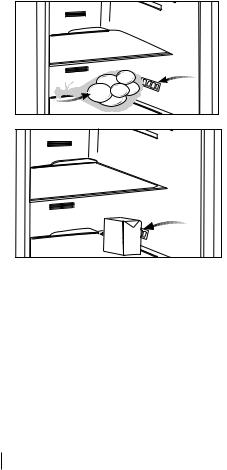
HCA Warning
If your product's cooling system contains R600a:
This gas is flammable. Therefore, pay attention to not damaging the cooling system and piping during usage and transportation. In the event of damage, keep your product away from potential fire sources that can cause the product catch a fire and ventilate the room in which the unit is placed.
Ignore this warning if your product's cooling system contains R134a.
Type of gas used in the product is stated in the type plate which is on the left wall inside the refrigerator.
Never throw the product in fire for
disposal.
Things to be done for energy saving
•Do not leave the doors of your refrigerator open for a long time.
•Do not put hot food or drinks in your refrigerator.
•Do not overload your refrigerator so that the air circulation inside of it is not prevented.
•Do not install your refrigerator under direct sunlight or near heat emitting appliances such as ovens, dishwashers or radiators.
•Pay attention to keep your food in closed containers.
•For products with a freezer compartment; You can store maximum amount of food items in the freezer when you remove the shelf or drawer of the freezer. Energy consumption value stated for your refrigerator has been determined by removing freezer shelf or drawer and under maximum load. There is no harm to use a shelf or drawer according to the shapes and
size of food to be frozen. |
7 |
|
•Thawing frozen food in fridge compartment will both provide energy saving and preserve the food quality.
Recommendations for freshfood compartment
* OPTIONAL
•Please do not let any foodstuff to come to contact with the temperature sensor in freshfood compartment.In order to maintain freshfood compartment at ideal storage temperature, the sensor must not be blocked by fodstuffs.
•Do not place hot foodstuff in your appliance.
food |
temperature |
sensor |
MILK |
temperature |
juice |
|
etc. |
sensor |
|
EN
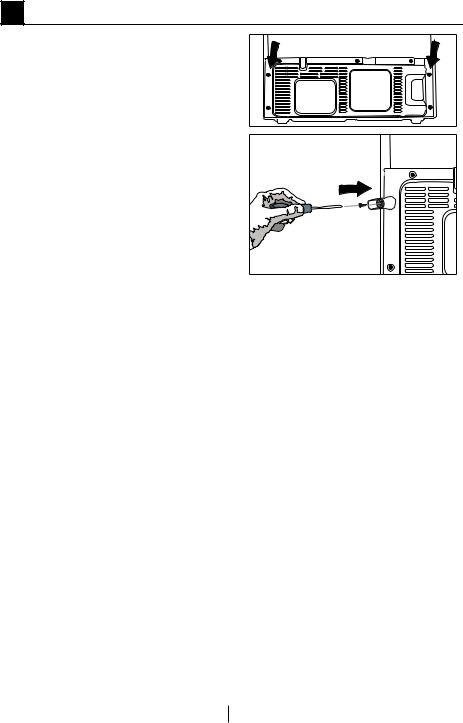
3 Installation
BPlease remember that the manufacturer shall not be held liable if the information given in the instruction manual is not observed.
Points to be considered when re-transporting your refrigerator
1.Your refrigerator must be emptied and cleaned prior to any transportation.
2.Shelves, accessories, crisper and etc. in your refrigerator must be fastened securely by adhesive tape against any jolt before repackaging.
3.Packaging must be tied with thick tapes and strong ropes and the rules of transportation printed on the package must be followed.
Please do not forget…
Every recycled material is an indispensable source for the nature and for our national resources.
If you wish to contribute to recycling the packaging materials, you can get further information from the environmental bodies or local authorities.
Before operating your refrigerator
Before starting to use your refrigerator check the following:
1.Is the interior of the refrigerator dry and can the air circulate freely in the rear of it?
2.Please install the 2 plastic wedges as illustrated in the figure. Plastic wedges will provide the required distance between your refrigerator and the wall in order to allow the air circulation. (The illustrated figure is only an example and does not match exactly with your product.)
3.Clean the interior of the refrigerator as recommended in the “Maintenance and cleaning” section.
4.You will hear a noise as the compressor starts up. The liquid and gases sealed within the refrigeration system may also give rise to noise, even if the compressor is not running and this is quite normal.
5.Front edges of the refrigerator may feel warm. This is normal. These areas are designed to be warm to avoid condensation
Electric connection
Connect your product to a grounded socket which is being protected by a fuse with the appropriate capacity.
Important:
•The connection must be in compliance with national regulations.
•The power cable plug must be easily accessible after installation.
•The specified voltage must be equal to your mains voltage.
8 EN

• Extension cables and multiway plugs must not be used for connection.
BA damaged power cable must be replaced by a qualified electrician.
BProduct must not be operated before it is repaired! There is danger of electric shock!
Disposing of the packaging
The packing materials may be dangerous for children. Keep the packing materials out of the reach of children or dispose of them by classifying them in accordance with the waste instructions. Do not dispose of them along with the normal household waste. The packing of your refrigerator is
produced from recyclable materials.
Disposing of your old refrigerator
Dispose of your old refrigerator without giving any harm to the environment.
•You may consult your authorised dealer or waste collection center of your municipality about the disposal of your refrigerator.
Before disposing of your refrigerator, cut out the electric plug and, if there are any locks on the door, make them inoperable in order to protect children against any danger.
Placing and Installation
AIf the entrance door of the room where the refrigerator will be installed is not wide enough for the refrigerator to pass through, then call the authorised service to have them remove the doors of your refrigerator and pass it sideways through the door.
1.Install your refrigerator to a place that allows ease of use.
2.Keep your refrigerator away from heat sources, humid places and direct sunlight.
3.There must be appropriate air ventilation around your refrigerator in order to achieve an efficient operation. If the refrigerator is to be placed in a recess in the wall, there must be at least 5 cm distance with the ceiling and at least 5 cm with the wall. If the floor is covered with a carpet, your product must be elevated 2.5 cm from the floor.
4.Place your refrigerator on an even floor surface to prevent jolts.
9 EN
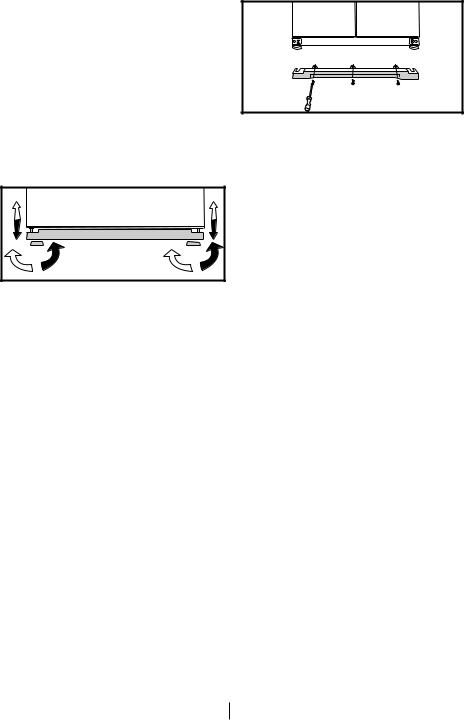
Adjusting the legs
If your refrigerator is unbalanced; You can balance your refrigerator by
turning the front legs of it as illustrated in the figure. The corner where the leg exists is lowered when you turn in the direction of black arrow and raised when you turn in the opposite direction. Taking help from someone to slightly lift the refrigerator will facilitate this process.
Floor balance adjustment
If your refrigerator is unbalanced; You can balance your refrigerator by
turning the front legs of it as illustrated in the figure. (See Figure A) The corner where the leg exists is lowered when you turn in the direction of black arrow
and raised when you turn in the opposite direction. Taking help from someone to slightly lift the refrigerator will facilitate this process.
 4
4
1 |
2 |
3 |
Door height adjustment
In case there is a problem with the alignment of the doors with respect to each other, they may be aligned by ascension vertically in the order given below. Ensure that door shelves are
empty when adjusting the door height. 1. Remove the lower ventilation cover by unscrewing its screws as shown in the figure below.
10 EN

4 Preparation
CYour refrigerator should be installed at least 30 cm away from heat sources such as hobs, ovens, central heater and stoves and at least 5 cm away from electrical ovens and should not be located under direct sunlight.
CPlease make sure that the interior of your refrigerator is cleaned thoroughly.
CIf two refrigerators are to be installed side by side, there should be at least 2 cm distance between them.
CWhen you operate your refrigerator for the first time, please observe the
following instructions during the initial six hours.
-The door should not be opened frequently.
-It must be operated empty without any food in it.
-Do not unplug your refrigerator. If a power failure occurs out of your control, please see the warnings in
the “Recommended solutions for the problems” section.
COriginal packaging and foam materials should be kept for future transportations or moving.
CThis appliance is designed to operate at temperatures specified in the table below is equipped with Advanced Electronic Temperature Control System [AETCS] which ensures that at the advised setting [4 - four on the knob] the frozen food in the freezer will not defrost even if the ambient temperature falls as low as -15 °C. When first installed the product MUST NOT be placed in low ambient temperatures because the freezer will not reduce to it’s standard operating temperature.
Once it has reached its steady operating state it can be re-located. So you
may then install your appliance in a garage or an unheated room without having to worry about frozen food in the freezer being spoilt. However at low ambient temperatures mentioned above, fridge contents are likely to freeze, so check and consume food in the fridge accordingly. When the
ambient temperature returns to normal, you may change the knob setting to suit your needs.
CIf the ambient temperature is below 0°C, the food in the fridge compartment will freeze.So, we recommend you don’t use the fridge compartment in such low ambient conditions. You can continue using the freezer compartment as usual.
11 EN
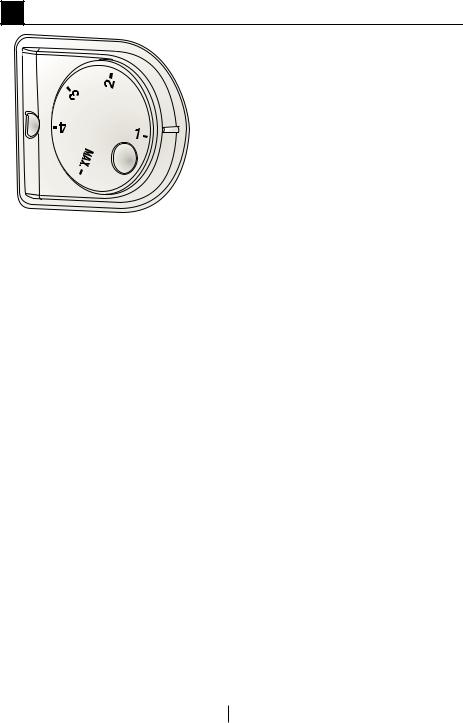
5 Using your refrigerator
Temperature setting button
Temperature setting button allows you to make the temperature setting of your refrigerator.
Setting the temperature of your refrigerator
The overall temperature setting of your refrigerator is made by means of the temperature setting button on the right wall of the fridge compartment. This button has 5 different temperature setting position. Select the position suitable to your needs.
Dual cooling system
Your refrigerator is equipped with two separate cooling systems to cool the fresh food compartment and freezer compartment. Thus, air in the fresh food compartment and freezer compartment do not get mixed. Thanks to these two separate cooling systems, cooling speed is much higher then other refrigerators. Odours in the compartments do not get mixed. Also additional power saving is provided since the automatic defrosting is performed individually.
12 EN
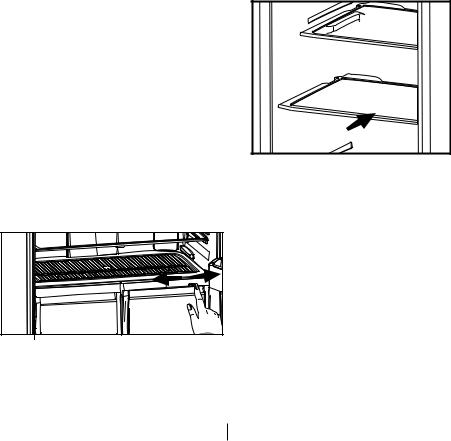
Hygiene - Ion
Hygiene+: The photocatalyst filter in the air channel of refrigerator helps to clean the air inside. Also this filter reduces bad smells.
Ion+: Ionizer, that is in the air channel of refrigerator, ionizers the air. With the help of this system airborne bacteria and bad smells originated from these bacteria will be reduced.
Humidity control in the crisper
Humidity level can be adjusted by sliding the humidity adjustment slider to the right or left.
•If you want to maintain humidity in this compartment, set the humidity adjustment slider to the closed position. (Left)
•If you want to eliminate humidity in this compartment, set the humidity adjustment slider to the open position. (Right)
Sliding Body Shelves
Sliding body shelves can be pulled by slightly lifting up from the front and moved back and forth. They come to a stop point when pulled towards front to allow you reach the foods placed at the back of the shelf; when it is pulled after
slightly lifted upwards at the second stop point, the body shelf will be released. The shelf should be hold tightly from the bottom as well in order to prevent it from tipping over. The body shelf is placed on the rails at the sides of the refrigerator body by bringing it to one lower or one upper level.
The body shelf should be pushed backwards to seat it completely.
 1 2
1 2
 3
3
4
13 EN
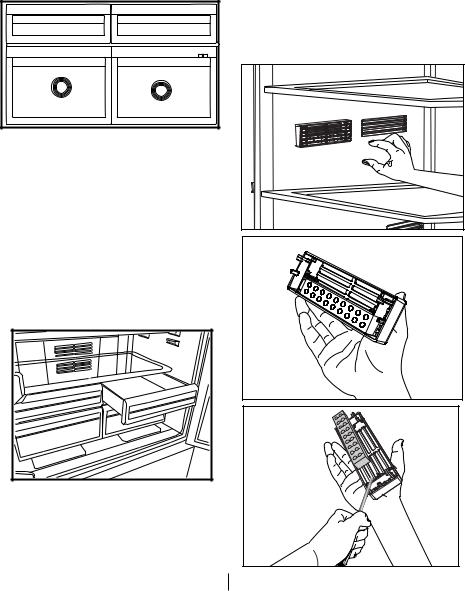
Blue light
(OPTIONAL)
Foodstuff stored in the crispers that are enlightened with a blue light continue their photosynthesis by means of the wavelength effect of blue light and thus, preserve their freshness and increase their vitamin content.
Description and cleaning of odor filter:
Odor filter prevents unpleasant odor build-up in your refrigerator.
Pull the cover, into which the odor filter is installed, downwards and remove as illustrated. Leave the filter under sunlight for one day. Filter will be cleaned during this time. Install the filter back to its place.
Odor filter must be cleaned once in a year.
Chiller compartment
(OPTIONAL)
This compartment is used to keep frozen food that needs to be thawed slowly (such as meat and fish). Chiller compartment is the coolest place in your refrigerator where you can keep dairy products, meat, fish and poultry under ideal storage conditions. Fruits and vegetables should not be stored in this compartment.
14 EN

Icematic and ice storage container
(OPTIONAL) Using the Icematic
Fill the Icematic with water and place it into its seat. Your ice will be ready approximately in two hours. Do not remove the Icematic from its seating to take ice.
Turn the knobs on it clockwise by 90 degrees.
Ice cubes in the cells will fall down into the ice storage container below.
You may take out the ice storage container and serve the ice cubes.
If you wish, you may keep the ice cubes in the ice storage container.
Ice storage container
Ice storage container is only intended for accumulating the ice cubes. Do not put water in it. Otherwise, it will break.
Making ice (OPTIONAL)
Fill the ice container with water and place it into its seat. Your ice will be ready approximately in two hours.
You can easily remove your ice by slightly twisting the ice container.
15 EN

Dual cooling system:
Your refrigerator is equipped with two separate cooling systems to cool the fresh food compartment and freezer compartment. Thus, air in the fresh food compartment and freezer compartment do not get mixed. Thanks to these two separate cooling systems, cooling speed is much higher then other refrigerators. Odours in the compartments do not
get mixed. Also additional power saving is provided since the defrosting is
performed individually.
Freezing fresh food
•Wrap or cover the food before placing them in the refrigerator.
•Hot food must cool down to the room temperature before putting them in the refrigerator.
•The foodstuff that you want to freeze must be fresh and in good quality.
•Foodstuff must be divided into portions according to the family’s daily or meal based consumption needs.
•The foodstuff must be packaged in an airtight manner to prevent them from drying even if they are going to be kept for a short time.
•Materials to be used for packaging must be tear-proof and resistant to cold, humidity, odor, oils and acids and they must also be airtight. Moreover, they must be well closed and they must be made from easy-to-use materials that are suitable for deep freeze usage.
•Frozen food must be used immediately after they are thawed and they should never be re-frozen.
•Please observe the following instructions to obtain the best results.
1.Do not freeze too large quantities of food at one time. The quality of the food is best preserved when it is frozen right through to the core as quickly as possible.
2.Placing warm food into the freezer compartment causes the cooling system to operate continuously until the food is frozen solid.
3.Take special care not to mix already frozen food and fresh food.
16 EN

Freezer |
Fridge |
|
|
Compartment |
Compartment |
Explanations |
|
Adjustment |
Adjustment |
|
|
|
|
|
|
-18°C |
4°C |
This is the normal recommended setting. |
|
|
|||
|
|
|
|
-20,-22 or |
4°C |
These settings are recommended when the ambient temperature |
|
-24°C |
exceeds 30°C. |
||
|
|||
|
|
Use when you wish to freeze your food in a short time. Your |
|
Quick Freeze |
4°C |
refrigerator will return to its previous mode when the process is |
|
|
|
over. |
|
|
|
If you think that your fridge compartment is not cold enough |
|
-18°C or colder |
2°C |
because of the hot conditions or frequent opening and closing of |
|
|
|
the door. |
|
|
|
You can use it when your fridge compartment is overloaded or if |
|
-18°C or colder |
Quick Fridge |
you wish to cool down your food rapidly. It is recommended that |
|
|
|
you activate quick fridge function 4-8 hours before placing the |
|
|
|
food. |
Recommendations for preservation of frozen food
•Prepacked commercially frozen food should be stored in accordance with the frozen food manufacturer's instructions for a  ( 4 star) frozen food storage compartment.
( 4 star) frozen food storage compartment.
•To ensure that the high quality achieved by the frozen food manufacturer and the food retailer is maintained, the following should be remembered:
1.Put packages in the freezer as quickly as possible after purchase.
2.Ensure that contents are labeled and dated.
3.Do not exceed "Use By", "Best Before" dates on the packaging.
Defrosting
The freezer compartment defrosts automatically.
Placing the food
Freezer |
Various frozen food |
|
such as meat, fish, ice |
||
compartment |
||
cream, vegetables and |
||
shelves |
||
etc. |
||
|
||
Egg tray |
Egg |
|
|
|
|
Fridge compartment |
Food in pans, covered |
|
plates and closed |
||
shelves |
||
containers |
||
|
||
|
Small and packaged |
|
Fridge compartment |
food or drinks (such |
|
door shelves |
as milk, fruit juice and |
|
|
beer) |
|
Crisper |
Vegetables and fruits |
|
Freshzone |
Delicatessen products |
|
(cheese, butter, salami |
||
compartment |
||
and etc.) |
||
|
Deep-freeze information
Food must be frozen as rapidly as possible when they are put in a refrigerator in order to keep them in good quality.
17 EN

The TSE norm requires (according to certain measurement conditions) the refrigerator to freeze at least 4.5 kg of foodstuff at 32°C ambient temperature to -18°C or lower within 24 hours for every 100-liters of freezer volume.
It is possible to keep the food for a long time only at -18°C or lower temperatures.
You can keep the freshness of food for many months (at -18°C or lower temperatures in the deep freeze).
WARNING! A
•Foodstuff must be divided into portions according to the family’s daily or meal based consumption needs.
•Foodstuff must be packaged in an airtight manner to prevent them from drying even if they are going to be kept for a short time.
Materials necessary for packaging:
•Cold resistant adhesive tape
•Self adhesive label
•Rubber rings
•Pen
Materials to be used for packaging the foodstuff must be tear-proof and
resistant to cold, humidity, odor, oils and acids.
Foodstuff to be frozen should not be allowed to come in contact with the previously frozen items to prevent their partial thawing.
Frozen food must be used immediately after they are thawed and they should never be re-frozen.
Changing the illumination lamp
To change the lamp used for illumination of your refrigerator, please call your
Authorized Service.
18 EN

Water dispenser
(OPTIONAL)
Water dispenser is a very useful feature to obtain chilled water without opening the door of your fridge. Since you do not have to open the door of your fridge frequently, you also save on electricitiy.
Using the water dispenser
Push in the lever of the water dispenser with your glass. By releasing the lever, you cut off the dispensing.
When operating the water dispenser, maximum flow is achieved by fully depressing the lever. Please note, how much water flows from the dispenser depends on how far you depress the lever. As the level of water in your cup / glass rises, gently reduce the amount of pressure on the lever to avoid overflow. If you depress the lever a small amount, then water will trickle; this is perfectly normal and is not a fault.
Filling in the water tank of water dispenser
Open the cap of the water tank as illustrated in the figure. Fill in with pure and clean drinking water. Close the cap.
Caution!
•Do not fill water tank with any liquid other than drinking water; beverages such as fruit juice, carbonated fizzy soda drinks, alcoholic drinks are not suitable for use with water dispenser. If such liquids are used, the water dispenser will malfunction and may be damaged beyond repair. The guarantee does not cover such uses. Some chemical ingredients and additives in such drinks / beverages may also attack and damage water tank material.
•Only use clean pure drinking water.
•Capacity of water dispenser tank is 3 litres [6.4 pints], do not overfill.
•Push the water dispenser lever with a rigid cup. If you are using a plastic disposable cup, then push the lever with your fingers from behind the cup.
19 EN

Cleaning the water tank
Remove the water tank,and detach the top cover mechanism from the water tank. Clean the water tank with warm clean water, reinstall the top cover. When installing the water tank, make sure that hooks it fits securely into the hangers on the door. Make sure that parts removed during cleaning (if any) are installed correctly into their original locations. Otherwise, water may leak.
Important:
Water tank and components of water dispenser are not dishwasher-proof.
Water tray
(OPTIONAL)
Water that drips while using the water dispenser accumulates in the drip tray. Remove the drip tray by pulling it
towards yourself and empty it from time to time.
Remove the plastic drainer part as shown in the diagram by pressing down on the edge.
20 EN

6 Maintenance and cleaning
A Never use gasoline, benzene or similar substances for cleaning purposes.
B We recommend that you unplug the appliance before cleaning.
B Never use any sharp abrasive instrument, soap, household cleaner, detergent and wax polish for cleaning.
CUse lukewarm water to clean the cabinet of your refrigerator and wipe it dry.
CUse a damp cloth wrung out in a solution of one teaspoon of bicarbonate of soda to one pint of water to clean the interior and wipe it dry.
B Make sure that no water enters the lamp housing and other electrical items.
B If your refrigerator is not going to be used for a long period of time, unplug the power cable, remove all food, clean it and leave the door ajar.
CCheck door seals regularly to ensure they are clean and free from food particles.
A To remove door racks, remove all the contents and then simply push the door rack upwards from the base.
ANever use cleaning agents or water that contain chlorine to clean the outer surfaces and chromium coated parts of the product. Chlorine causes corrosion on such metal surfaces.
Protection of plastic surfaces
CDo not put the liquid oils or oil-cooked meals in your refrigerator in unsealed containers as they damage the plastic surfaces of your refrigerator. In case of spilling or smearing oil on the plastic surfaces, clean and rinse the relevant part of the surface at once with warm water.
21 EN

7 Troubleshooting
Please review this list before calling the service. It will save your time and money. This list includes frequent complaints that are not arising from defective workmanship or material usage. Some of the features described here may not exist in your product.
The refrigerator does not operate.
•The plug is not inserted into the socket correctly. >>> Insert the plug into the socket securely.
•The fuse of the socket which your refrigerator is connected to or the main fuse have blown out. >>> Check the fuse.
Condensation on the side wall of the fridge compartment (MULTIZONE, COOL CONTROL and FLEXI ZONE).
•Ambient is vey cold. >>> Do not install the refrigerator in places where the temperature falls below 10 °C.
•Door has been opened frequently. >>> Do not open and close the door of refrigerator frequently.
•Ambient is vey humid. >>> Do not install your refrigerator into highly humid places.
•Food containing liquid is stored in open containers. >>> Do not store food with liquid content in open containers.
•Door of the refrigerator is left ajar. >>> Close the door of the refrigerator.
•Thermostat is set to a very cold level. >>> Set the thermostat to a suitable level.
Compressor is not running
CProtective thermic of the compressor will blow out during sudden power failures or plug-out plug-ins as the refrigerant pressure in the cooling system of the refrigerator has not been balanced yet. The refrigerator will start running
approximately after 6 minutes. Please call the service if the refrigerator does not startup at the end of this period.
•The refrigerator is in defrost cycle. >>> This is normal for a full-automatically defrosting refrigerator. Defrosting cycle occurs periodically.
•The refrigerator is not plugged into the socket. >>> Make sure that the plug is fit into the socket.
•Temperature settings are not made correctly. >>> Select the suitable temperature value.
•There is a power failure. >>> Refrigerator returns to normal operation when the power restores.
22 EN

The operation noise increases when the refrigerator is running.
CThe operating performance of the refrigerator may change due to the changes in the ambient temperature. It is normal and not a fault.
The refrigerator is running frequently or for a long time.
CNew product may be wider than the previous one. Larger refrigerators operate for a longer period of time.
•The ambient temperature may be high. >>> It is normal that the product operates for longer periods in hot ambient.
•The refrigerator is plugged in or loaded with food recently. >>> When the refrigerator is plugged in or loaded with food recently, it will take longer for it to attain the set temperature. This is normal.
•Large amounts of hot food may have been put in the refrigerator recently. >>>
Do not put hot food into the refrigerator.
•Doors are opened frequently or left ajar for a long time. >>>The warm air that has entered into the refrigerator causes the refrigerator to run for longer periods. Do not open the doors frequently.
•Freezer or fridge compartment door is left ajar. >>> Check if the doors are closed completely.
•The refrigerator is adjusted to a very low temperature. >>> Adjust the refrigerator temperature to a warmer degree and wait until the temperature is achieved.
•Door seal of the fridge or freezer may be soiled, worn out, broken or not properly seated. >>> Clean or replace the seal. Damaged/broken seal causes the refrigerator to run for a longer period of time in order to maintain the current temperature.
Freezer temperature is very low while the fridge temperature is sufficient.
•The freezer temperature is adjusted to a very low value. >>> Adjust the freezer temperature to a warmer degree and check.
Fridge temperature is very low while the freezer temperature is sufficient.
•The fridge temperature is adjusted to a very low value. >>> Adjust the fridge temperature to a warmer degree and check.
Food kept in the fridge compartment drawers are frozen.
•The fridge temperature is adjusted to a very low value. >>> Adjust the fridge temperature to a warmer value and check.
23 EN

Temperature in the fridge or freezer is very high.
•The fridge temperature is adjusted to a very high value. >>> Fridge compartment temperature setting has an effect on the temperature of the freezer. Change the temperatures of the fridge or freezer and wait until the relevant compartments attain a sufficient temperature.
•Doors are opened frequently or left ajar for a long time. >>> Do not open the doors frequently.
•Door is ajar. >>> Close the door completely.
•The refrigerator is plugged in or loaded with food recently. >>> This is normal. When the refrigerator is plugged in or loaded with food recently, it will take longer for it to attain the set temperature.
•Large amounts of hot food may have been put in the refrigerator recently. >>>
Do not put hot food into the refrigerator.
Vibrations or noise.
•The floor is not level or stable. >>>If the refrigerator rocks when moved slowly, balance it by adjusting its legs. Also make sure that the floor is strong enough to carry the refrigerator, and level.
•The items put onto the refrigerator may cause noise. >>> Remove the items on top of the refrigerator.
There are noises coming from the refrigerator like liquid flowing or spraying.
CLiquid and gas flows happen in accordance with the operating principles of your refrigerator. It is normal and not a fault.
Whistle comes from the refrigerator.
C Fans are used in order to cool the refrigerator. It is normal and not a fault.
Condensation on the inner walls of refrigerator.
CHot and humid weather increases icing and condensation. It is normal and not a fault.
•Doors are opened frequently or left ajar for a long time. >>> Do not open the doors frequently. Close them if they are open.
•Door is ajar. >>> Close the door completely.
24 EN

Humidity occurs on the outside of the refrigerator or between the doors.
CThere may be humidity in the air; this is quite normal in humid weather. When the humidity is less, condensation will disappear.
Bad odor inside the refrigerator.
•No regular cleaning is performed. >>> Clean the inside of the refrigerator regularly with a sponge, lukewarm water or sodium bicarbonate diluted in water.
•Some containers or package materials may cause the smell. >>> Use a different container or different brand packaging material.
•Food is put into the refrigerator in uncovered containers. >>> Keep the food in closed containers. Microorganisms spreading out from uncovered
containers can cause unpleasant odors.
CRemove the foods that have expired best before dates and spoiled from the refrigerator.
The door is not closing.
•Food packages are preventing the door from closing. >>> Replace the packages that are obstructing the door.
•The refrigerator is not completely even on the floor. >>> Adjust the legs to balance the refrigerator.
•The floor is not level or strong. >>> Make sure that the floor is level and capable to carry the refrigerator.
Crispers are stuck.
•The food is touching the ceiling of the drawer. >>> Rearrange food in the drawer.
25 EN
Bitte lesen Sie zuerst diese Anleitung!
Lieber Kunde,
Wir sind sicher, dass Ihnen dieses Produkt, das in modernsten Fertigungsstätten hergestellt und den strengsten Qualitätsprüfungen unterzogen wurde, lange Zeit gute Dienste leisten wird.
Wir empfehlen Ihnen, vor Inbetriebnahme des Gerätes das gesamte Handbuch durchzulesen und es anschließend aufzubewahren.
Diese Anleitung...
•hilft Ihnen, Ihr Gerät schnell und sicher zu bedienen.
•Lesen Sie die Anleitung, bevor Sie Ihr Gerät aufstellen und bedienen.
•Halten Sie sich an die Anweisungen, beachten Sie insbesondere die Sicherheitshinweise.
•Bewahren Sie die Anleitung an einem leicht zugänglichen Ort auf, damit Sie jederzeit darin nachlesen können.
•Lesen Sie auch die weiteren Dokumente, die mit Ihrem Produkt geliefert wurden. Bitte beachten Sie, dass diese Anleitung eventuell auch für andere Geräte eingesetzt werden kann.
Symbole und ihre Bedeutung
In dieser Anleitung finden Sie die folgenden Symbole:
C Wichtige Informationen oder nützliche Tipps.
AWarnung vor Verletzungen oder Beschädigungen.
BWarnung vor elektrischem Strom.

INHALT
1 Der Kühlschrank/ |
3 |
|
5 So bedienen Sie |
|
|
Gefrierschrank |
|
Ihren Kühlschrank/ |
|
||
|
|
|
Gefrierschrank |
13 |
|
2 Wichtige Hinweise zu Ihrer |
|||||
|
Temperatureinstellknopf |
13 |
|||
Sicherheit |
4 |
|
|||
|
Temperatur einstellen....................... |
13 |
|||
Bestimmungsgemäßer Gebrauch |
4 |
||||
|
Doppeltes Kühlsystem..................... |
13 |
|||
Bei Geräten mit Wasserspender:........ |
6 |
|
Hygiene - Ion+................................. |
14 |
|
Kinder – Sicherheit............................. |
6 |
|
Feuchtigkeitskontrolle im |
|
|
HCA-Warnung |
6 |
|
|
||
|
Gemüsefach |
14 |
|||
Erfüllung von WEEE-Vorgaben zur |
|
|
|||
|
|
Verschiebbare Ablagen |
14 |
||
Entsorgung von Altgeräten: |
7 |
|
|||
|
Blaues Licht..................................... |
15 |
|||
Einhaltung von RoHS-Vorgaben:........ |
7 |
|
Kühlfach |
15 |
|
Hinweise zur Verpackung |
7 |
|
|||
|
Eisbereiter und Eisbehälter |
16 |
|||
Tipps zum Energiesparen |
7 |
|
|||
|
Eis herstellen |
16 |
|||
Empfehlungen zum Kühlbereich |
8 |
|
|||
|
Beschreibung und Hinweise zur |
|
|||
3 Installation |
9 |
|
Reinigung des Geruchsfilters:........... |
17 |
|
|
|
|
Doppeltes Kühlsystem: |
18 |
|
Was Sie bei einem weiteren Transport |
|||||
|
Frische Lebensmittel einfrieren |
18 |
|||
Ihres Kühlschrank / Gefrierschranks |
|
|
|||
|
|
Empfehlungen zur Konservierung von |
|||
beachten müssen |
9 |
|
|||
|
gefrorenen Lebensmitteln |
19 |
|||
Bevor Sie Ihren Kühlschrank / |
|
|
|||
|
|
Lebensmittel einlagern |
19 |
||
Gefrierschrank einschalten |
9 |
|
|||
|
Hinweise zum Tiefkühlen |
20 |
|||
Elektrischer Anschluss |
10 |
|
|||
|
Beleuchtung austauschen |
20 |
|||
Verpackungsmaterialien entsorgen... |
10 |
|
|||
Altgeräte entsorgen |
10 |
|
Wasserspender................................ |
21 |
|
|
Tropfschale |
22 |
|||
Aufstellung und Installation |
10 |
|
|||
|
|
|
|||
Füße einstellen................................. |
11 |
|
6 Wartung und Reinigung 23 |
||
Gerade, ausbalancierte Aufstellung.. |
11 |
|
Schutz der Kunststoffflächen ........... |
23 |
|
4 Vorbereitung |
12 |
|
7 Empfehlungen zur |
|
|
|
|
24 |
|||
|
|
|
Problemlösung |
||
2 DE
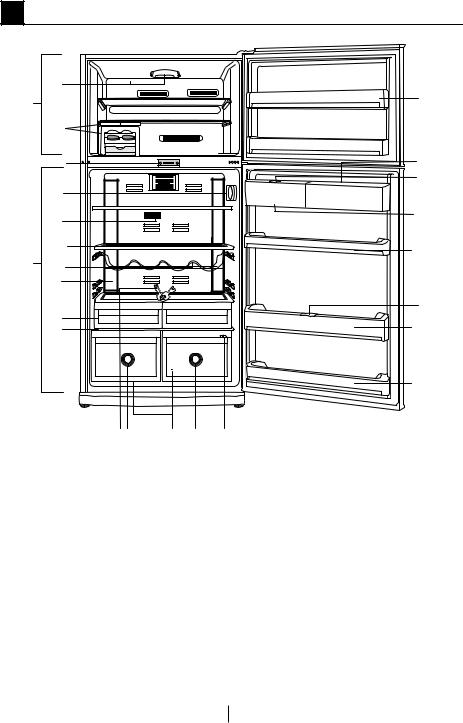
1 Der Kühlschrank/ Gefrierschrank
|
21 |
1 |
22 |
|
|
|
|
|
|
*20 |
|
|
*19 |
4 |
|
|
*2 |
|
18 |
|
|
17 |
*3 |
|
|
|
|
14 |
6 |
23 |
* |
|
16 |
|
|
|
15 |
|
|
*13 |
*5 |
|
6 |
|
|
12 |
|
|
|
6 |
|
|
|
|
|
|
*19*9 |
|
|
|
|
|
|
|
|
|
|
|
|
|
|
|
|
|
|
|
|
|
|
|
|
|
7 |
1110*9 |
8 7 |
|
|
|
||||
1. |
Tiefkühlbereich. |
-Türablagen |
|
|
|
13. Kühlfach. |
|
|
|
||||
2. |
Wasserspendertankkappe. |
|
|
|
14. Kühlbereich-Glasablagen |
||||||||
3. |
Wasserspendertank. |
|
|
|
15. Kühlbereich. |
-Innenbeleuchtung |
|||||||
4. |
Eierhalter. |
|
|
|
|
|
|
16. Weinablage. |
|
|
|
||
5. |
Flaschenhalter. |
|
|
|
|
17. Geruchsfilter. |
(Kohlefilter) |
||||||
6. |
Kühlbereich. |
-Türablagen |
|
|
|
18. Kühlbereichtemperatur-Einstellknopf |
|||||||
7. |
Einstellbare. |
Füße |
|
|
|
19. Schlüssel. |
|
|
|
||||
8. |
Gemüse. |
-/Kühlfach-Einstellschieber |
|
20. Eisbereiter oder Eiswürfelschale |
|||||||||
9. |
Blaues. |
Licht |
|
|
|
|
21. Tiefkühlbereich. |
-Innenbeleuchtung |
|||||
10. Belüftungsdeckel. |
|
|
|
22. Tiefkühlbereich |
|
||||||||
11. Gemüsefächer. |
|
|
|
|
23. Kühlbereich |
|
|
|
|||||
12. Gemüsefachabdeckung. |
|
|
|
|
|
|
|
||||||
* Sonderzubehör
C Abbildungen und Angaben in dieser Anleitung sind schematisch und können etwas von Ihrem Gerät abweichen. Falls Teile nicht zum Lieferumfang des erworbenen Gerätes zählen, gelten sie für andere Modelle.
3 DE

2 Wichtige Hinweise zu Ihrer Sicherheit
Bitte lesen Sie die folgenden Hinweise |
unmittelbar nach der Entnahme aus dem |
|
aufmerksam durch. Bei Nichtbeachtung |
Tiefkühlbereich ist nicht ratsam. (Dies kann |
|
kann es zu Verletzungen und Sachschäden |
zu Erfrierungen führen.) |
|
kommen. In diesem Fall erlöschen auch |
• Bei Geräten mit Tiefkühlbereich: |
|
sämtliche Garantieund sonstigen |
Bewahren Sie Getränke in Flaschen sowie |
|
Ansprüche. |
Dosen niemals in Tiefkühlbereich auf. |
|
Die reguläre Einsatzzeit des von Ihnen |
Diese platzen. |
|
erworbenen Gerätes beträgt 10 Jahre. |
• Berühren Sie gefrorene Lebensmittel nicht |
|
In diesem Zeitraum halten wir Ersatzteile |
||
mit der Hand; sie können festfrieren. |
||
für das Gerät bereit, damit es stets wie |
||
• Ziehen Sie den Netzstecker, bevor Sie |
||
gewohnt arbeiten kann. |
||
den Kühlschrank / Gefrierschrank reinigen |
||
|
||
Bestimmungsgemäßer |
oder abtauen. |
|
• Verwenden Sie niemals Dampfoder |
||
Gebrauch |
||
Dieses Produkt ist für folgende |
Sprühreiniger zum Reinigen oder Abtauen |
|
Ihres Kühlschrank / Gefrierschranks. Die |
||
Einsatzzwecke vorgesehen: |
Dämpfe oder Nebel können in Kontakt |
|
– Nutzung in Innenräumen; beispielsweise |
mit stromführenden Teilen geraten |
|
im Privathaushalt |
und Kurzschlüsse oder Stromschläge |
|
– Einsatz in Geschäftsräumen; |
auslösen. |
|
• Missbrauchen Sie niemals Teile Ihres |
||
beispielsweise in Geschäften und Büros |
||
– Verwendung auf Bauernhöfen oder in |
Kühlschrank / Gefrierschranks (z. B. Tür) |
|
als Befestigungen oder Kletterhilfen. |
||
Beherbergungsbetrieben; beispielsweise |
||
• Nutzen Sie keine elektrischen |
||
in Hotels und Pensionen |
||
• Das Gerät sollte nicht im Freien benutzt |
Geräte innerhalb des Kühlschrank / |
|
Gefrierschranks. |
||
werden. |
||
• Achten Sie darauf, den Kühlkreislauf |
||
|
||
Allgemeine Hinweise zu Ihrer |
keinesfalls mit Bohroder |
|
Sicherheit |
Schneidwerkzeugen zu beschädigen. |
|
• Wenn Sie das Gerät entsorgen |
Das Kühlmittel kann herausspritzen, |
|
wenn die Gaskanäle des Verdunsters, |
||
möchten, wenden Sie sich am besten |
||
Rohrund Schlauchleitungen oder |
||
an den autorisierten Kundendienst. Hier |
||
Oberflächenversiegelungen beschädigt |
||
erhalten Sie notwendige Informationen |
||
werden. Dies kann zu Hautreizungen und |
||
und erfahren, welche Stellen für die |
||
Augenverletzungen führen. |
||
Entsorgung zuständig sind. |
||
|
||
• Bei Problemen und Fragen zum Gerät |
• Decken Sie keinerlei Belüftungsöffnungen |
|
des Kühlschrank / Gefrierschranks ab. |
||
wenden Sie sich grundsätzlich an den |
||
|
||
autorisierten Kundendienst. Ziehen Sie |
• Elektrogeräte dürfen nur von autorisierten |
|
keine Dritten zu Rate, versuchen Sie nichts |
Fachkräften repariert werden. Reparaturen |
|
in Eigenregie, ohne den autorisierten |
durch weniger kompetente Personen |
|
Kundendienst davon in Kenntnis zu |
können erhebliche Gefährdungen des |
|
setzen. |
Anwenders verursachen. |
|
• Bei Geräten mit Tiefkühlbereich: Der |
• Sollten Fehler oder Probleme während der |
|
Verzehr von Speiseeis und Eiswürfeln |
Wartung oder Reparaturarbeiten auftreten, |
4 DE
